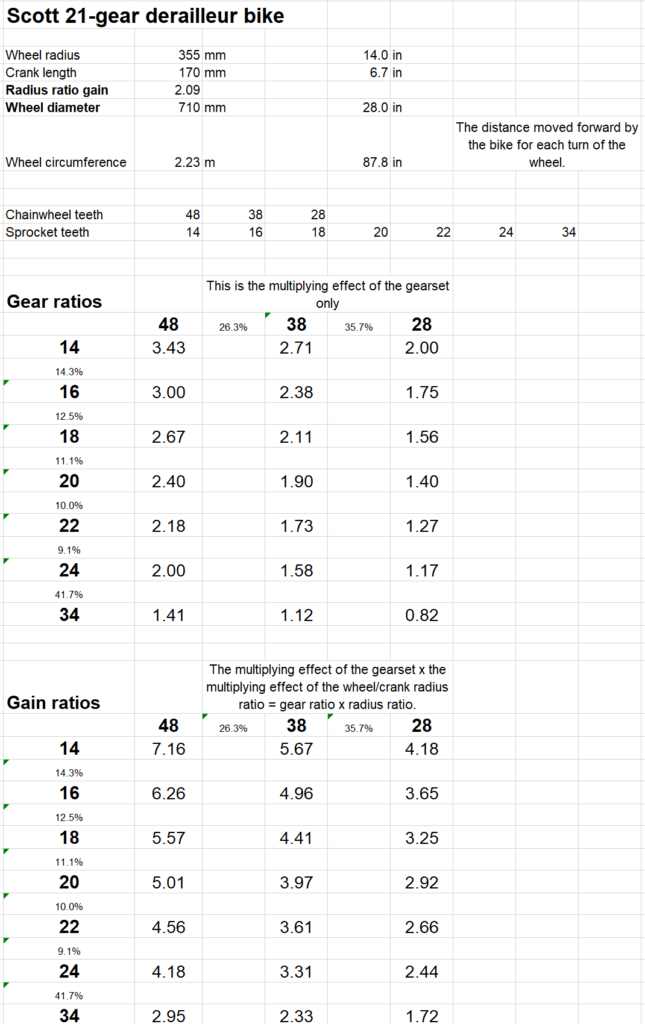This has now been superseded by an adjacent post
Bikes ‘gear up’ our feet’s movement so we can travel more quickly than with feet alone. This gearing up happens in three stages.
Radius gain
Our feet press on pedals which turn the cranks which are typically 170 mm radius. But the bike wheels are bigger than that, even on my Dahon folding bike where they are 500 mm diameter, or 250 mm radius. The radius gain is the ration of the wheel radius to the crank radius, in this case:
250 mm/170 mm = 1.47
Chainwheel-sprocket gain
The cranks turn a chainwheel which, on my Dahon folding bike, has 47 teeth. The chainwheel drives a rear sprocket which has 17 teeth. The chainwheel-sprocket gain is the ratio of the chainwheel to the sprocket, in this case:
47/17 = 2.76
Internal hub gain
My Dahon has a hub gear at the rear which has a top ratio of 1.545 and a bottom ratio of 0.632, gearing down in the low gears.
Overall gain ratio
The overall gain ratio is radius gain x chainwheel-sprocket gain x internal hub gain.
So in top gear where the internal hub gain is 1.545:
overall gain ratio = 1.47 x 2.76 x 1.545 = 6.3
In top gear, the bike is moving six times as fast as the cyclist’s feet. Imagine you were walking briskly at 4 mph. If your feet are moving at the same speed on the bike pedals, you will be travelling at 6 x 4 = 24 mph.
Metres development
This is the distance travelled by the bike (in metres) per rotation of the cranks.
When you turn the cranks once, your feet travel round a circle of radius 170 mm, 0.17 m. The diameter of that circle, d, is 0.34 m. The distance travelled all the way round the circle, d, is πd, where π is about 3.142.
So the distance travelled by the feet for one rotation of the crank:
= πd = 3.142 x 0.34 = 1.07 m.
When the cranks are turned 1 turn, the feet move a distance of 1.07 m. The bike travels 6.27 times as far:
= 1.07 x 6.27 = 6.7 metres.
This distance of 6.7 m is the development of my Dahon, meaning that in top gear it travels 6.7 metres for each turn of the cranks.
Bottom gear ratio
The internal hub gain is actually a reduction for bottom gear, where it is 0.632. So the overall gain ratio in bottom gear = 1.47 x 2.76 x 0.632 = 2.56.
The development = 1.07 x 2.56 = 2.7 m.
Calculating the gears for a derailleur bike
Make a table like this for your derailleur bike and fill in the blanks. If you have more than 7 sprockets on the rear cassette the table will need to be wider.

Here are the figures for my derailleur bike. I’ve also added some boxes and highlighted them in red for a few calculations.

To calculate the diameter in inches, divide the mm figure by 25.4.
Here are the above calculations complete and the chainwheel and sprocket figures rearranged to complete a gear table for them.

I’ve completed some of the figures so you can see how they are calculated – by dividing the number of chainwheel teeth by the sprocket teeth to give the chainwheel-sprocket gain.
Here is the completed gear table, ready for us to complete the calculations.

There is no internal hub gear on this derailleur bike. So the overall gain ratio in top gear:
= radius gain x chainwheel-sprocket gain
= 2.09 x 3.4 = 7.1
Bottom overall gain ratio:
= radius gain x chainwheel-sprocket gain
= 2.09 x 0.8 = 1.7
Metres development
It’s hardly worth calculating the development because we know that the development in metres is roughly equal to the overall gear ratio. I leave the calculations to you.
Comparing my two bikes

It’s obvious why I struggle with my Dahon on steep hills. Perhaps I don’t need the very low overall gain of the Scott. But something lower than 2.6 would be helpful up steeper hills.
Gear inches
There is one more unit used to measure gears – gear inches, the diameter of an equivalent high wheel (penny-farthing) bike.
Gear inches are calculated by wheel diameter x gear ratio
So the top-gear inches for my derailleur bike are:
28 inches x 3.4 = 95″
This means that the top gear on this bike is like riding a penny-farthing with a front wheel 8 ft (2.4 m) in diameter.
A useful fudge, or quick conversion
Closely enough:
100 gear inches = 8 metres development = 7.5 metres gain ratio.
Complete figures for my Scott derailleur bike.
Here we are!

